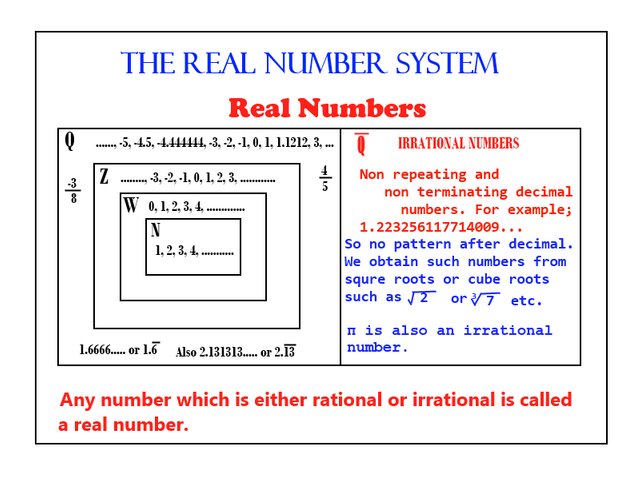The Real Number System
Numbers from basics to high school level
Natural Numbers: Numbers which we learn naturally or from our surroundings are called natural numbers. These numbers are often found in nature. We don’t have to go to school to learn these numbers. We can group these numbers as follows:
1, 2, 3, 4, 5, 6, 7,………………..and so on.
This group is represented by letter N = {1, 2, 3, 4, . . . . . . . . . }
So the smallest natural number is 1 and the greatest natural number is unknown which is also called as infinity (∞).
Whole Numbers: When we include nothing (I mean zero) to the natural numbers then the new group becomes the whole numbers. They are represented by the letter W and can be written in a group as shown below:
W = {0, 1, 2, 3, 4, 5, 6, 7, 8, 9 . . . . . . . . .}
So the smallest whole number is zero and largest is again infinity.
Note that the group of whole numbers contains all the natural numbers and we just have one extra number “0” than the natural numbers.
Did you notice that we only use 0 to 9 to make all the rest of the numbers? That is also a reason we call them the whole numbers.
Integers: We need integers when we have to go below zero. For example, when your bank account is overdrawn how would you describe it by using whole numbers? So we needed negative numbers too. Other examples are such as temperatures below zero and depth of a submarine in a sea.
We represent integers by the letter Z or I as shown below: Z = {………..,-3, -2, -1, 0, 1, 2, 3, ……………}
Note: There is neither the smallest integer nor the largest integer.
So far we have classified the numbers into three groups and the largest one is of Integers and there are all the whole numbers and natural numbers in this group.
Rational Numbers: A rational number is any number which can be written in the form of p/q , where “p” and “q” are integers and “q” can’t be zero but every other integer. Letter Q is used to denote the group of rational numbers.
Here students need to be careful as all the integers (hence whole numbers and natural numbers) can be written in the form of p/q by writing “1” as the denominator. For example; 5 and 5/1 are equal, similarly -9 and -9/1 are equal.
So we can conclude that all the integers are rational numbers too.
But there are an infinite numbers which are rational numbers but not integers. For example; or 0.5, or -1.75 are rational numbers but not in the group of integers. Key point to remember is that all the terminating decimals and non- terminating but repeating decimals are rational numbers. For example; 3.225 is a terminating decimal as it has only three decimal places hence it is a rational number. 2.66666666…….. is a non-terminating but repeating decimal hence this is also a rational number.
Irrational Numbers: Numbers which are not rational are called irrational numbers. These are the numbers which are not perfect square roots, cube roots or fourth roots. There is a caveat though; remember when you get a perfect square like square root of 4, which is not an irrational number as it gives you 2 as answer which is a rational number (also a whole number and a natural number). So square root of perfect squares or cube roots of perfect cubes are not irrational numbers but they are rational numbers.
Irrational numbers are non-terminating and non-repeating decimals (keep in mind NON-TERMINATING and NON-REPEATING decimal numbers). Another example is the number pi (π) which is also an irrational number.
Real Numbers: Any number which is either rational or irrational is called a real number. Finally we can group all the above numbers as shown below:
